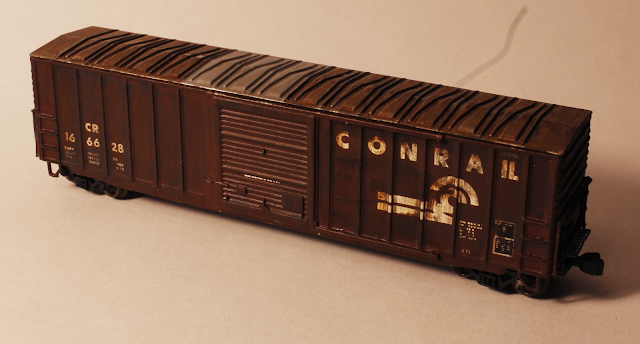The historical information that I was able gather about the X71
Class boxcars can be found on the Conrail Historical Society website, www.thecrhs.org. The X71 class boxcar that I
am modeling comes from the 1000 car order that the Penn Central placed in 1971
with American Car Foundry. They were used for "clean" loading for items that needed to be ship in a disinfected environment or for paper items. These cars, being relatively new once Conrail
started in 1976, had a long service life in the Conrail years and they could
possibly be still in service after the Norfolk Southern/CSX split in the late
1990’s.
This boxcar started out as an Atlas Precision Design 50 foot
boxcar painted in Burlington Northern. After coming across a photo of a similar
boxcar in the X71 class with a Penn Central (PC) green door on it, I knew I had
to model something similar to it. The project started off by removing the end
mounted safety rails, food boards and brake wheel. The car was dipped in
Scalecoat Paint Remover then washed with soap and water. It was set aside to
dry for a day. Next, the car was painted with Floquil Tuscan Red, the sides and
ends were painted but I left both doors alone at this time. Next came silver
for the top of the car. Once dry, I chose to paint one door in PC green and the
other in Tuscan Red to simulate a car that had damage to its original door and
was replaced quickly at the nearest car shop on the Conrail system. There will
always be a debate over with color matches what color in the model railroading
hobby, with that said, I chose Model Master Russian Interior Green to represent
the PC green. After the doors were painted and the model was dry it was sprayed
with Testors Gloss cote. After some appropriate drying time for the clear cote,
the car was decaled. The decals are from Microscale set number 60-1046, there
is a lot of small lettering in this set. I highly recommend using a magnifier
when working with N scale decals. Once the decaling was finished, the car
received a layer of dull cote.
Weathering for this car consists of enamel paint and artist
oil paints. It started with a layer of Floquil weathered black being brushed on
heavily and then quickly wiped away from top to bottom on all sides of the car,
this technic creates a great base layer of grime for the next layer of rust. The
car was again sprayed with dull cote to seal the enamel paint before the oil
paint is applied. Oil paint rust is created with Winsor and Newton raw sienna
and burnt umber. The darker of the two is first laid out in a horizontal line
near the door tracks and then the lighter of the two is place in a line just
underneath it. Then, using a wider brush, the two colors are streaked down to
create a rust spot that has worn into the car from the harsh weather elements
over the years. The roof got a similar treatment but a patch of silver was left
new, to simulate a set of roof panels replaced. The car was then sealed for a
final time with dull cote. TRWBM.


